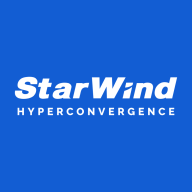


NetApp FAS Series and StarWind Storage Appliance compete in the storage solutions sector. StarWind has the upper hand in affordability and quality support, whereas NetApp FAS is favored for its extensive features and high performance.
Features: NetApp FAS Series offers diverse functionalities with deduplication, high availability, and unified protocol support, enhancing its capabilities. It excels in performance with snapshot technology and FlashCache. StarWind focuses on affordability with features like performance-enhanced all-flash arrays, iSCSI support, and ease of management, catering to simplified setups.
Room for Improvement: NetApp FAS Series can improve its monitoring tools and documentation and address cost concerns while enhancing integration options with backup vendors and licensing transparency. StarWind users report a need for improved initial synchronization and dashboard features, often missing from the free version.
Ease of Deployment and Customer Service: Both solutions mainly deploy on-premises, with NetApp also supporting hybrid cloud environments. NetApp's support is generally considered responsive and knowledgeable despite some mixed support tier reviews. StarWind's support is praised for its reliability, particularly in on-premises settings.
Pricing and ROI: NetApp FAS Series is seen as pricey, with a licensing structure enabling users to pay for only necessary features, delivering a positive ROI in VMware environments despite initial costs. StarWind is valued for its competitive pricing and simple licensing parameters, making it a preferred choice for budget-conscious buyers.
By opting for the gold subscription every three years, you get a free upgrade to the latest controller release.
If you wait more than seven years to buy another one, you get a return on your investment.
If you have the configuration well maintained and configured, you should have good efficiency and compression for the clients and for yourself.
We also had one outage where a controller of one of the products had failed and had to be replaced on-site.
Customers always have their issues resolved promptly.
Pure has good storage.
Sometimes, the support was inadequate because the initial architecture was poorly defined.
We are also using it ourselves for the SAN and CIFS protocol.
They often provide basic solutions, such as suggesting a failover or a power cycle, which are not the sophisticated solutions we expect from a vendor.
It is highly scalable.
It is suitable for both medium-sized and enterprise businesses.
It hasn't broken down anytime in the last six to seven years, despite hurricanes, earthquakes, and power outages.
We normally avoid current versions and use versions that have been running for at least two months in client usage before updating drivers.
NetApp FAS Series is scalable, and it is possible, but you need to pay.
The NetApp FAS Series is scalable and offers numerous solutions, but only if customers are willing to invest in the shelves.
During the eight years, there have been no problems such as hardware failure or stopping.
I would rate the stability of the solution as a ten out of ten.
I would rate the stability of the product at seven out of ten.
When panic occurs on the node, it reboots itself, and we have experienced numerous hardware-related issues.
Most things are tailor-made, and we avoid downtimes even with primitive CLI commands.
We would appreciate a built-in transparent failover in the next release to eliminate the need for a separate metro cluster.
I'm eagerly anticipating the roadmap's promise of introducing multiple controllers, which could significantly boost scalability and resilience.
We mostly rely on long-term releases. We don't need the most up-to-date features, but we need a reliable environment.
Storage companies should create encrypted storage solutions between the OS and storage to protect against ransomware attacks.
Nutanix leads the business in this approach, and I feel that NetApp is missing some aspects, such as CPU, GPU, and RAM, in its AI portfolio.
There is an opportunity there for NetApp with Cloud Volumes ONTAP.
While the prices may be higher than those of other vendors, we see it as a market leader with benefits.
The support can be a bit pricey, but the solution is more cost-effective than anything else out there.
I would give it a nine out of ten in terms of costliness.
The pricing of NetApp FAS Series is not cheap, but in comparison to other vendors, NetApp FAS Series is affordable.
Pure Storage has signature security technology, which cannot be deleted, even if you are an administrator.
The platform's robust features include excellent sustainability tracking, and a comprehensive dashboard offering insights into IOPS, bandwidth, performance, and virtual activities.
Its data compression feature is the best that we have ever seen.
While NVMe disks are expensive and require three disks for parity calculations, hard drives in NetApp FAS Series are inexpensive, making it more cost-efficient per GB, even with RAID tech implementation.
Our IOPS are very high, reaching somewhere about 50k to 150k or 1.150k.
One important feature for customers is its ease of use and continuity, enabling seamless usage across on-premise and cloud environments.



| Company Size | Count |
|---|---|
| Small Business | 15 |
| Midsize Enterprise | 11 |
| Large Enterprise | 12 |
| Company Size | Count |
|---|---|
| Small Business | 31 |
| Midsize Enterprise | 37 |
| Large Enterprise | 57 |
| Company Size | Count |
|---|---|
| Small Business | 5 |
| Midsize Enterprise | 3 |
| Large Enterprise | 2 |
Pure Storage FlashArray//X is the world’s first enterprise-class, all-NVMe flash storage array. It represents a new class of storage – shared accelerated storage, which is a term coined by Gartner – that delivers major breakthroughs in performance, simplicity, and consolidation.
NetApp FAS series is an enterprise-level storage system that provides a wide variety of data management services, including data protection, block and file storage, and data management.
NetApp FAS is designed to be highly scalable, allowing your organization to grow storage capacity on demand. NetApp FAS also supports multiple protocols, including NFS, SMB, iSCSI, and Fibre Channel, as well as various storage architectures, including SAN (Storage Area Network) and NAS (Network-Attached Storage).
The FAS series has multiple data protection and data management features, including snapshots, cloning, replication, and deduplication, to help secure your data and manage it more efficiently. The system integrates with other NetApp products and solutions, to create a unified data management platform. The system can be deployed on-premise, on multi-cloud environments, or hybrid.
NetApp FAS Series Benefits and Features
NetApp FAS series provides its users with several key benefits and features, including:
Reviews from Real Users
NetApp FAS Series stands out among its competitors for a number of reasons. Several major ones are its speed, reliability, and a wide variety of features.
Adriano S., IT project and infrastructure service manager, writes, “The replication feature is noteworthy because it's faster than most and it uses little bandwidth. Then there's the friendly interface that the equipment offers. With this interface, it is very easy to manage.”
Temitope O., a NetApp product manager at Hiperdist Ltd, says, “I like the unified management feature because sometimes you end up running a single protocol on the entire system. You rather have a system for a particular protocol and another system for other protocols, especially in a big environment like mine.”
For SMB and Enterprises who are looking for high performance primary storage for server virtualization, VDI, database and Big Data scenarios, or inexpensive secondary backup tier, our solution is StarWind Storage Appliance. It unifies commodity servers, disks and flash, and associated software into an easily scalable storage platform.
Additionally, the appliance features an optional gateway to Azure public cloud, which helps to implement an effective Disaster Recovery plan or meet regulatory requirements. StarWind SA scales up by adding individual disks and flash modules, or JBODs, while adding ready controller nodes allows scaling out.
StarWind SA targets those, who need high-performance primary storage or secondary storage for backup. In case there is a whole virtualization infrastructure to build from scratch, StarWind HCA will come in handy. Otherwise, if all the required hardware is present, StarWind Virtual SAN will be enough to build a high-performance virtualization setup.
We monitor all NAS reviews to prevent fraudulent reviews and keep review quality high. We do not post reviews by company employees or direct competitors. We validate each review for authenticity via cross-reference with LinkedIn, and personal follow-up with the reviewer when necessary.